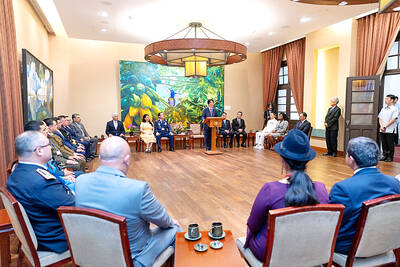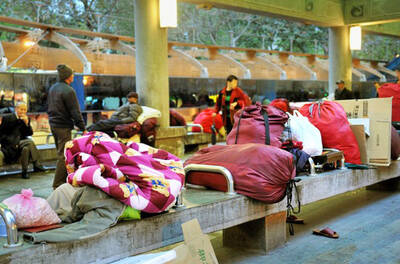Training with drones would become necessary, and drone training would be included alongside precision missile drills conducted by different military units, a source said on Saturday.
As various units continue to receive drones, joint operations training integrating uncrewed platforms with land, sea and air forces would become necessary, the source said, adding that such training might even be a part of this year’s Han Kuang live-fire exercises.
To counter ongoing intimidation by the Chinese People’s Liberation Army, the military has been acquiring various categories of armaments, including those that could bolster asymmetric warfare capabilities and defense resilience, they said, adding that drones form part of those efforts.

Photo: Daniel Ceng, AP
Former US Indo-Pacific commander Admiral John Aquilino introduced the idea of using drones to defend Taiwan in what he coined the “hellscape” strategy in August 2023.
The strategy is an asymmetric warfare concept that involves deploying thousands of low-cost uncrewed drones, ships and submarines in large numbers to delay or even destroy enemy forces in a storm-like swarm attack. US Indo-Pacific Commander Admiral Samuel Paparo has since reaffirmed the concept in an interview in June last year.
However, a significant effort would be required to reach the capabilities needed to implement such a strategy, the sources said.
“Although the military has demonstrated drone capabilities in major exercises such as the Han Kuang military drills and has closely monitored Chinese warships, drone operations have mostly been limited to reconnaissance missions involving single units,” they said.
Integrating drones into joint combat operations or live-fire exercises is a complex and risky endeavor, and Taiwan has very few designated sea and air training zones, necessitating careful planning and further discussions before engaging in such exercises, they said.
Understanding how uncrewed platforms integrate with other military equipment requires further research, Democratic Progressive Party Legislator Puma Shen (沈伯洋) said.
While there is no complete plan for uncrewed surface vessels yet, the integration of drones with land, sea and air forces, along with drone logistics and live-fire testing, must be strengthened, he said, adding that the military should look at incorporating civilian drones into military operations.
“Also, joint training with drones should aim to enhance overall combat effectiveness. Merely testing drones’ range and visual targeting capabilities during drills would be meaningless,” said Shen, who is cochair of the legislative Foreign and National Defense Committee.
Shu Hsiao-huang (舒孝煌), a researcher at the government-funded think tank Institute for National Defense and Security Research, agreed with the need to incorporate drone training into military drills.
“Only through precision live-fire exercises and the Han Kuang drills can Taiwan validate the reliability of the military technologies it is developing, and the effectiveness of its combat concepts,” he said.
Commenting on how drones could improve combat capabilities, Shu cited the example of the M142 HIMARS multiple rocket launcher system, which arrived in Taiwan in October last year, but was absent from last year’s Han Kuang exercises.
Given the HIMARS’ extended range beyond traditional visual targeting, drones are essential for target acquisition when using the system, he said.
As for advancing the hellscape strategy, Shu said that the key lies in reducing costs and adopting the mindset of treating suicide drones as expendable munitions.
Future attack drone strategies should leverage AI technology to enhance coordination and mission allocation of drones, he said.
The Chungshan Institute of Science and Technology is heading in the right direction with its research into such technologies, he said.
“Once the navy establishes its littoral combat command, it should consider acquiring uncrewed platforms to serve as supplementary firepower,” he said.

Costa Rica sent a group of intelligence officials to Taiwan for a short-term training program, the first time the Central American country has done so since the countries ended official diplomatic relations in 2007, a Costa Rican media outlet reported last week. Five officials from the Costa Rican Directorate of Intelligence and Security last month spent 23 days in Taipei undergoing a series of training sessions focused on national security, La Nacion reported on Friday, quoting unnamed sources. The Costa Rican government has not confirmed the report. The Chinese embassy in Costa Rica protested the news, saying in a statement issued the same

Taiwan’s Liu Ming-i, right, who also goes by the name Ray Liu, poses with a Chinese Taipei flag after winning the gold medal in the men’s physique 170cm competition at the International Fitness and Bodybuilding Federation Asian Championship in Ajman, United Arab Emirates, yesterday.

A year-long renovation of Taipei’s Bangka Park (艋舺公園) began yesterday, as city workers fenced off the site and cleared out belongings left by homeless residents who had been living there. Despite protests from displaced residents, a city official defended the government’s relocation efforts, saying transitional housing has been offered. The renovation of the park in Taipei’s Wanhua District (萬華), near Longshan Temple (龍山寺), began at 9am yesterday, as about 20 homeless people packed their belongings and left after being asked to move by city personnel. Among them was a 90-year-old woman surnamed Wang (王), who last week said that she had no plans

TO BE APPEALED: The environment ministry said coal reduction goals had to be reached within two months, which was against the principle of legitimate expectation The Taipei High Administrative Court on Thursday ruled in favor of the Taichung Environmental Protection Bureau in its administrative litigation against the Ministry of Environment for the rescission of a NT$18 million fine (US$609,570) imposed by the bureau on the Taichung Power Plant in 2019 for alleged excess coal power generation. The bureau in November 2019 revised what it said was a “slip of the pen” in the text of the operating permit granted to the plant — which is run by Taiwan Power Co (Taipower) — in October 2017. The permit originally read: “reduce coal use by 40 percent from Jan.